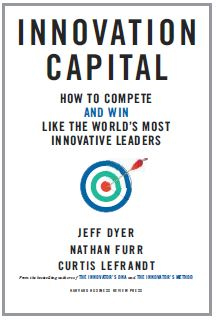Innovation Capital: How Do Leaders Win Support For Their Ideas?
By Nathan Furr & Jeff Dyer


THE 4 SOURCES OF INNOVATION CAPITAL
We interviewed some of the world’s greatest leaders of innovation — including superstars like Jeff Bezos, Elon Musk, and Mark Benioff — and found that they don’t leave it to chance. Instead, they purposefully and thoughtfully build up their innovation capital so they can use it to bring innovations to life. Innovation capital isn’t tangible, like money or equipment. It is an intangible force, like political capital, that helps you win backing for your ideas. We found it comes from four sources.
First, innovation capital comes from who you are — what we could call your innovation-specific human capital. That may sound simpler than it is. The leaders we studied demonstrated three specific qualities: forward thinking, creative problem solving, and persuading. Forward thinking means spending time envisioning the future, and then positioning yourself to be there. Creative problem solvers tackle problems proactively with ingenuity and determination. Finally, these innovators build up their creative and persuasive abilities in order to sell people on their ideas.
The second source of innovation capital comes from who you know, or what we would call your innovation- specific social capital. Who do you know, such as investors, innovators, or others in your network, who can support an idea?
 Third, innovation capital comes from what you are known for, or your innovation-specific reputation capital. The best way to build this is by gaining some experience as a founder or leader of an initiative. You also can build innovation capital by tackling difficult projects and getting noticed for being good at strategic prioritization or just being scrappy and efficient with resources.
Third, innovation capital comes from what you are known for, or your innovation-specific reputation capital. The best way to build this is by gaining some experience as a founder or leader of an initiative. You also can build innovation capital by tackling difficult projects and getting noticed for being good at strategic prioritization or just being scrappy and efficient with resources.
All the above contribute to innovation capital and are considered when a potential sponsor weighs whether or not to support you and your innovation project. Fourth and finally, you can strengthen your innovation capital with what we refer to as impression amplifiers (i.e., visible actions that gain attention and credibility for you and your ideas).
Being successful as an entrepreneur or innovator requires conscientious thought being applied toward building your innovation capital. Because innovation capital isn’t something you are born with, it’s something hard to build and, if not careful, easy to lose.
NATHAN FURR, PH.D., is an assistant professor of strategy at INSEAD, where he teaches innovation and technology strategy.
JEFF DYER, PH.D., is the Horace Beesley professor of strategy at Brigham Young University's Marriott School of Business.
